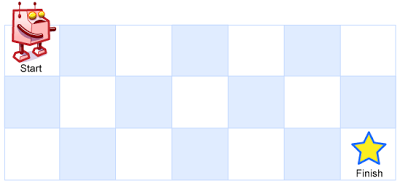LeetCode in Racket
62. Unique Paths
Medium
There is a robot on an m x n grid. The robot is initially located at the top-left corner (i.e., grid[0][0]). The robot tries to move to the bottom-right corner (i.e., grid[m - 1][n - 1]). The robot can only move either down or right at any point in time.
Given the two integers m and n, return the number of possible unique paths that the robot can take to reach the bottom-right corner.
The test cases are generated so that the answer will be less than or equal to 2 * 109.
Example 1:

Input: m = 3, n = 7
Output: 28
Example 2:
Input: m = 3, n = 2
Output: 3
Explanation: From the top-left corner, there are a total of 3 ways to reach the bottom-right corner:
-
Right -> Down -> Down
-
Down -> Down -> Right
-
Down -> Right -> Down
Constraints:
1 <= m, n <= 100
Solution
(define (calc-path! start end direction cache other-p)
(begin (if (string=? direction "v")
(for ([i (in-range start end)])
(if (= other-p 0)
(hash-set! cache (list 0 i) 1)
(hash-set! cache
(list other-p i)
(+ (hash-ref cache (list (- other-p 1) i))
(hash-ref cache (list other-p (- i 1)))))))
(for ([i (in-range start end)])
(if (= other-p 0)
(hash-set! cache (list i 0) 1)
(hash-set! cache (list i other-p)
(+ (hash-ref cache (list i (- other-p 1)))
(hash-ref cache (list (- i 1) other-p)))))))
cache))
(define (dp-path x y target-x target-y cache)
(if (and (>= x target-x) (>= y target-y))
(hash-ref cache (list (- target-x 1) (- target-y 1)))
(let* ([cache
(begin
(when (<= x target-x) (calc-path! x (add1 target-x) "h" cache y))
(when (<= y target-x) (calc-path! y (add1 target-y) "v" cache x))
cache)]
[x (if (< x target-x) (add1 x) x)]
[y (if (< y target-y) (add1 y) y)])
(dp-path x y target-x target-y cache))))
(define (start-dp target-x target-y)
(dp-path 0 0 target-x target-y (make-hash)))
(define/contract (unique-paths m n)
(-> exact-integer? exact-integer? exact-integer?)
(start-dp m n))

